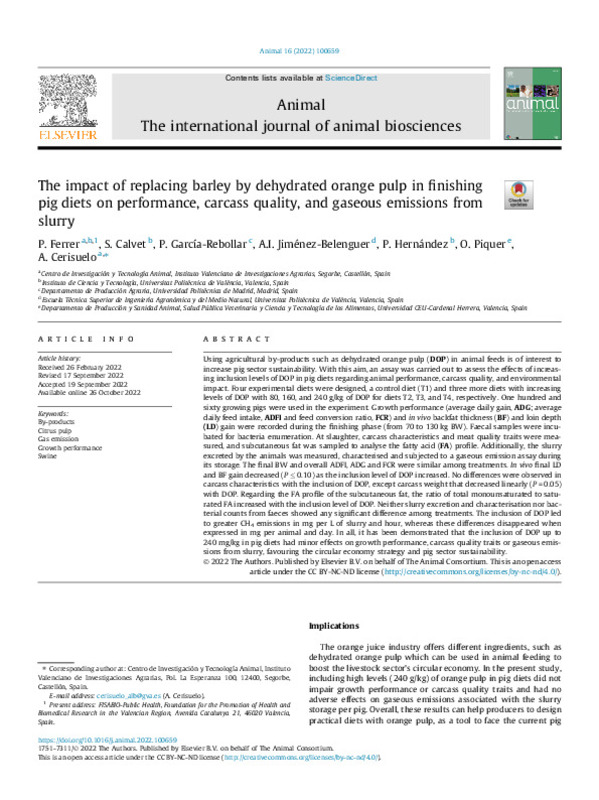JavaScript is disabled for your browser. Some features of this site may not work without it.
Buscar en RiuNet
Listar
Mi cuenta
Estadísticas
Ayuda RiuNet
Admin. UPV
The impact of replacing barley by dehydrated orange pulp in finishing pig diets on performance, carcass quality, and gaseous emissions from slurry
Mostrar el registro sencillo del ítem
Ficheros en el ítem
| dc.contributor.author | Ferrer, P.
|
es_ES |
| dc.contributor.author | Calvet, S.
|
es_ES |
| dc.contributor.author | García-Rebollar, P.
|
es_ES |
| dc.contributor.author | Jiménez Belenguer, Ana Isabel
|
es_ES |
| dc.contributor.author | Hernández, Pilar
|
es_ES |
| dc.contributor.author | Piquer, O.
|
es_ES |
| dc.contributor.author | Cerisuelo, A.
|
es_ES |
| dc.date.accessioned | 2023-05-23T18:02:00Z | |
| dc.date.available | 2023-05-23T18:02:00Z | |
| dc.date.issued | 2022-11 | es_ES |
| dc.identifier.issn | 1751-7311 | es_ES |
| dc.identifier.uri | http://hdl.handle.net/10251/193545 | |
| dc.description.abstract | [EN] Using agricultural by-products such as dehydrated orange pulp (DOP) in animal feeds is of interest to increase pig sector sustainability. With this aim, an assay was carried out to assess the effects of increas-ing inclusion levels of DOP in pig diets regarding animal performance, carcass quality, and environmental impact. Four experimental diets were designed, a control diet (T1) and three more diets with increasing levels of DOP with 80, 160, and 240 g/kg of DOP for diets T2, T3, and T4, respectively. One hundred and sixty growing pigs were used in the experiment. Growth performance (average daily gain, ADG; average daily feed intake, ADFI and feed conversion ratio, FCR) and in vivo backfat thickness (BF) and loin depth (LD) gain were recorded during the finishing phase (from 70 to 130 kg BW). Faecal samples were incu-bated for bacteria enumeration. At slaughter, carcass characteristics and meat quality traits were mea-sured, and subcutaneous fat was sampled to analyse the fatty acid (FA) profile. Additionally, the slurry excreted by the animals was measured, characterised and subjected to a gaseous emission assay during its storage. The final BW and overall ADFI, ADG and FCR were similar among treatments. In vivo final LD and BF gain decreased (P <= 0.10) as the inclusion level of DOP increased. No differences were observed in carcass characteristics with the inclusion of DOP, except carcass weight that decreased linearly (P = 0.05) with DOP. Regarding the FA profile of the subcutaneous fat, the ratio of total monounsaturated to satu-rated FA increased with the inclusion level of DOP. Neither slurry excretion and characterisation nor bac-terial counts from faeces showed any significant difference among treatments. The inclusion of DOP led to greater CH4 emissions in mg per L of slurry and hour, whereas these differences disappeared when expressed in mg per animal and day. In all, it has been demonstrated that the inclusion of DOP up to 240 mg/kg in pig diets had minor effects on growth performance, carcass quality traits or gaseous emis-sions from slurry, favouring the circular economy strategy and pig sector sustainability. | es_ES |
| dc.description.sponsorship | This project was funded by the Spanish Ministry of Science and Innovation (AGL2014-56653). | es_ES |
| dc.language | Inglés | es_ES |
| dc.publisher | Cambridge University Press | es_ES |
| dc.relation.ispartof | Animal | es_ES |
| dc.rights | Reconocimiento - No comercial - Sin obra derivada (by-nc-nd) | es_ES |
| dc.subject | By-products | es_ES |
| dc.subject | Citrus pulp | es_ES |
| dc.subject | Gas emission | es_ES |
| dc.subject | Growth performance | es_ES |
| dc.subject | Swine | es_ES |
| dc.subject.classification | MICROBIOLOGIA | es_ES |
| dc.subject.classification | PRODUCCION ANIMAL | es_ES |
| dc.title | The impact of replacing barley by dehydrated orange pulp in finishing pig diets on performance, carcass quality, and gaseous emissions from slurry | es_ES |
| dc.type | Artículo | es_ES |
| dc.identifier.doi | 10.1016/j.animal.2022.100659 | es_ES |
| dc.relation.projectID | info:eu-repo/grantAgreement/AEI/Plan Estatal de Investigación Científica y Técnica y de Innovación 2017-2020/RTI2018-095246-B-C22/ES/UTILIZACION DE SUBPRODUCTOS FIBROSOS MEJORADOS EN PIENSOS DE PORCINO PARA INCREMENTAR LA SALUD INTESTINAL Y LA SOSTENIBILIDAD DE LA PRODUCCION PORCINA/ | es_ES |
| dc.relation.projectID | info:eu-repo/grantAgreement/MINECO//AGL2014-56653-C3-1-R/ES/VALORIZACION INTEGRAL DE SUBPRODUCTOS AGROINDUSTRIALES MEDITERRANEOS (ORUJO GRASO DE ACEITUNA Y PULPA DE CITRICOS) PARA REDUCIR EL IMPACTO AMBIENTAL DE LA PRODUCCION PORCINA/ | es_ES |
| dc.rights.accessRights | Abierto | es_ES |
| dc.contributor.affiliation | Universitat Politècnica de València. Escuela Técnica Superior de Ingeniería Agronómica y del Medio Natural - Escola Tècnica Superior d'Enginyeria Agronòmica i del Medi Natural | es_ES |
| dc.description.bibliographicCitation | Ferrer, P.; Calvet, S.; García-Rebollar, P.; Jiménez Belenguer, AI.; Hernández, P.; Piquer, O.; Cerisuelo, A. (2022). The impact of replacing barley by dehydrated orange pulp in finishing pig diets on performance, carcass quality, and gaseous emissions from slurry. Animal. 16(11):1-9. https://doi.org/10.1016/j.animal.2022.100659 | es_ES |
| dc.description.accrualMethod | S | es_ES |
| dc.relation.publisherversion | https://doi.org/10.1016/j.animal.2022.100659 | es_ES |
| dc.description.upvformatpinicio | 1 | es_ES |
| dc.description.upvformatpfin | 9 | es_ES |
| dc.type.version | info:eu-repo/semantics/publishedVersion | es_ES |
| dc.description.volume | 16 | es_ES |
| dc.description.issue | 11 | es_ES |
| dc.identifier.pmid | 36308921 | es_ES |
| dc.relation.pasarela | S\476321 | es_ES |
| dc.contributor.funder | Ministerio de Economía y Competitividad | es_ES |
| dc.contributor.funder | Ministerio de Ciencia, Innovación y Universidades | es_ES |








